Toxic Tide - Discovering the Health Effects of the Deepwater Disaster, Part 2
Air Date: Week of February 18, 2011
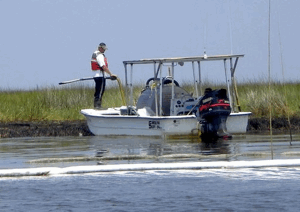
Fishermen turned their boats into an oil spill armada. Now many worry about what they were exposed to on the water. (Photo: Marco Kaltofen)
Sick residents have questions and scientists are looking for answers: might the BP spill be behind a wave of illness? We hear how cleanup workers and coastal communities might have been exposed in part two of Jeff Young’s report Toxic Tide - Discovering the Health Effects of the Deepwater Disaster.
Transcript
GELLERMAN: It’s Living on Earth, I’m Bruce Gellerman. From a scientific perspective the BP oil disaster was a giant, unintended, experiment. There had never been an oil disaster of such magnitude, in such deep water, where so much chemical dispersant was used. Now, 10 months later, Gulf coast residents are reporting a wave of strange illnesses that many suspect are related to the spill.
Some who say they have symptoms are workers who cleaned the crude from the sea and beaches. Others live along the coast where oil washed ashore. All are searching for answers – and scientists now have some surprising findings on how they may have been exposed. Here’s Living on Earth’s Jeff Young with the second part of his investigative special: Toxic Tide - Discovering the Health Effects of the Deepwater Disaster.
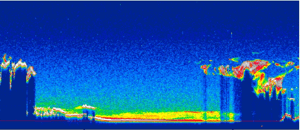
A NASA image of air above the Deepwater spill in May, 2010, as seen with the remote sensing technology known as Lidar. The red indicates aerosols over the spill. (NASA)
YOUNG: We’ll call him “John” - he does not want to use his real name. From June through November, John worked for a company BP hired to clean up oil in Louisiana’s hard hit Barataria Bay. His boat had a vacuum device to suck up the oil and dispersant mixture. Often, he’d smell it before he saw it.
“JOHN”: You could smell the hydrocarbons in the air and just smell that oil and you knew it was coming in. As the wind blew, some days you’d get really nauseous - our skin would itch a lot, and, it was just tough.
YOUNG: John says he was not offered use of a respirator or other protective gear. Some crewmembers quit out of health concerns. Now he’s wondering about health effects, too.
“JOHN”: There were many times when we felt that, you know, we were getting sick and we probably should have had respirators on. And, to this day, I’m pretty upset because I just was not informed of the contaminants that could affect me and my life as I go down the road.
YOUNG: In one way, John’s story is like many others from spill responders concerned about chemical exposure during their work on the Gulf. But John’s story is different in that his comes with hard data, thanks to a personal air-monitoring device.
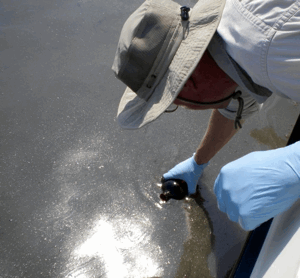
Marco Kaltofen says samples he collected show chemical dispersants closer to shore and much later than they should have been used. (Marco Kaltofen)
KALTOFEN: What I’ve got in this little tube is…
[RATTLING SOUND]
KALTOFEN: This is a small cartridge. It looks like a small brass pen.
YOUNG: Civil engineer Marco Kaltofen shows the device John wore.
KALTOFEN: As they move through the oil and dispersant, these tiny samplers, with no moving parts, are picking up those chemicals. So we can take them back to the laboratory and measure what was in the air they were breathing while they were working.
YOUNG: Kaltofen is a researcher at Worcester Polytechnic Institute in Massachusetts. He’s also head of an environmental research company called Boston Chemical, which was hired by a New Orleans personal injury law firm to collect samples. Kaltofen says samples from monitors clipped to John and other fishermen-turned-cleanup workers showed what are called “BTEX” compounds.

Fishermen turned their boats into an oil spill armada. Now many worry about what they were exposed to on the water. (Marco Kaltofen)
KALTOFEN: BTEX stands for benzene, toluene, ethylbenzene and xylenes. These are some of the lightest, most readily volatile compounds that are out there in that dispersant crude oil mix. And that’s where we found something very interesting, too. It was not the crude oil that was responsible for most of the volatile compounds we’re seeing, but it was actually the dispersant.
YOUNG: Why do you say that?
KALTOFEN: When we took the dispersant and the crude oil into the laboratory to measure how they partition - how they divide up into the different parts in the environment. When we did that, and we looked at the air above our tanks of seawater, we were finding that the same volatile chemicals that were in the air around the fishermen were the ones that we found in the air above the dispersant-seawater mixtures.
YOUNG: Those volatile chemicals likely come from the petroleum distillates mixed with the Corexit brand dispersants. At least 1.8 million gallons of chemical dispersants were used during the spill.
The chemicals most prevalent in the lab tests can affect the cardiovascular and nervous systems, liver, and kidneys. Corexit maker Nalco declined comment, citing litigation. Kaltofen says he had another surprising finding: he found dispersants closer to shore than they should have been used.
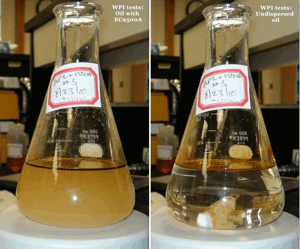
Lab tests show the chemical dispersants emit volatile organic compounds, a potential health concern. (Marco Kaltofen)
KALTOFEN: It’s confusing to us that we can go one mile off of Biloxi and find dispersant in the seawater - enough that it reeks because of the hydrocarbon odors. And when we got those samples into the lab, we found that we had multiple hits for dispersant compounds. So how could they get into the inshore waters and how could they still be there weeks after application supposedly ended? We need to get a better explanation.
YOUNG: The presidentially-appointed oil spill commission looked into the persistent citizen complaints that dispersants were being sprayed too close to shore. A commission staffer says reviews of Coast Guard operation logs found no evidence to support that.
Kaltofen’s work gives us some ideas about how those working on the water might have been exposed to toxics. But what about people who live along the coast? Robin Young of Orange Beach, Alabama, is among the many Gulf Coast residents who say they fell ill not long after oil started coming ashore.
R. YOUNG: We have way too many people that are sick with very odd symptoms that they have never experienced before in their life. So there’s something going on!
YOUNG: The Environmental Protection Agency monitored air quality during the spill and reported few incidents that would raise a health concern. But University of California Santa Barbara oceanographer Ira Leifer is taking a close look at how coastal communities might have been affected.

UC-Santa Barbara scientist Ira Leifer coordinated NASA’s remote sensing mission during the BP blowout. (George Foulsham, UCSB Office of Public Affairs)
Leifer was chief mission scientist for NASA’s airborne remote sensing during the spill. Measurements and images from satellites, aircraft, and ships give him a good picture of how components of the oil traveled from the sea and into the air. The same method used to measure the thickness of oil slicks on water, for example, also revealed oil in clouds.
LEIFER: Where there was some of these clouds, they showed up as if they had almost a millimeter of oil in the cloud. And these hydrocarbon-laden clouds - when they reach land - would in fact rain oil.
Leifer thinks this oil rain is an unprecedented oil spill phenomenon - a combination of the Gulf’s high humidity and the columns of thick smoke from burning oil. A lot of things about the BP blowout made it unlike other oil spills.
Most spills happen all at once, say, when a tanker or pipe ruptures. The BP wellhead kept spewing for 87 days, sending oil to the surface in a plume that Leifer says kept pushing the oil’s toxic chemicals into the air.
LEIFER: Air sampling that was conducted both on a boat and by NOAA in the atmosphere showed that this plume contained numerous components and that these components were…many of them are toxic, bearing some similarity to the volatiles you might find in gasoline.
YOUNG: Prevailing winds could have carried those chemicals onshore. Leifer wanted to know what that might mean for public health. The scientific literature on toxicology and oil spills is thin. So he instead used well-known health data from chronic exposure to gasoline and plugged that data into his model.
LEIFER: By that measure, my quick calculation suggested that for an adult healthy persona: maybe an effect, maybe not. For a baby, levels were a thousand to ten thousand times where one starts to see effects.
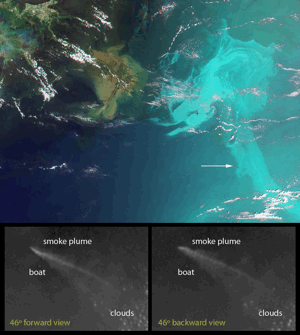
NASA image from summer 2010 shows the oil slick and a plume of smoke from burning oil. Ira Leifer says remote sensing data confirm the phenomenon of “oil rain.” (NASA)
YOUNG: Leifer is quick to add caveats - his results have not yet been tested and his model makes assumptions that might prove wrong. But he thinks it’s important for health researchers to follow through, focusing on the implications for infants, the elderly, and others more susceptible to chemical exposure.
The National Institutes of Health will soon launch a large-scale, long-term health study of cleanup workers. And the NIH just called for proposals to study community health effects of the spill. If the number of anecdotal reports of illness around the Gulf is any indication, there’s no shortage of work to be done. For Living on Earth, I’m Jeff Young.
GELLERMAN: You can hear part one of Jeff’s special report, find out a lot more about what was in the air during the spill, and see some eye-popping NASA images of the BP oil disaster at our website LOE dot ORG.
Links
EPA’s testing of chemical dispersant toxicity
The Centers for Disease Control data on oil spill health surveillance
Living on Earth wants to hear from you!
Living on Earth
62 Calef Highway, Suite 212
Lee, NH 03861
Telephone: 617-287-4121
E-mail: comments@loe.org
Newsletter [Click here]
Donate to Living on Earth!
Living on Earth is an independent media program and relies entirely on contributions from listeners and institutions supporting public service. Please donate now to preserve an independent environmental voice.
NewsletterLiving on Earth offers a weekly delivery of the show's rundown to your mailbox. Sign up for our newsletter today!
 Sailors For The Sea: Be the change you want to sea.
Sailors For The Sea: Be the change you want to sea.
 The Grantham Foundation for the Protection of the Environment: Committed to protecting and improving the health of the global environment.
The Grantham Foundation for the Protection of the Environment: Committed to protecting and improving the health of the global environment.
 Contribute to Living on Earth and receive, as our gift to you, an archival print of one of Mark Seth Lender's extraordinary wildlife photographs. Follow the link to see Mark's current collection of photographs.
Contribute to Living on Earth and receive, as our gift to you, an archival print of one of Mark Seth Lender's extraordinary wildlife photographs. Follow the link to see Mark's current collection of photographs.
 Buy a signed copy of Mark Seth Lender's book Smeagull the Seagull & support Living on Earth
Buy a signed copy of Mark Seth Lender's book Smeagull the Seagull & support Living on Earth

